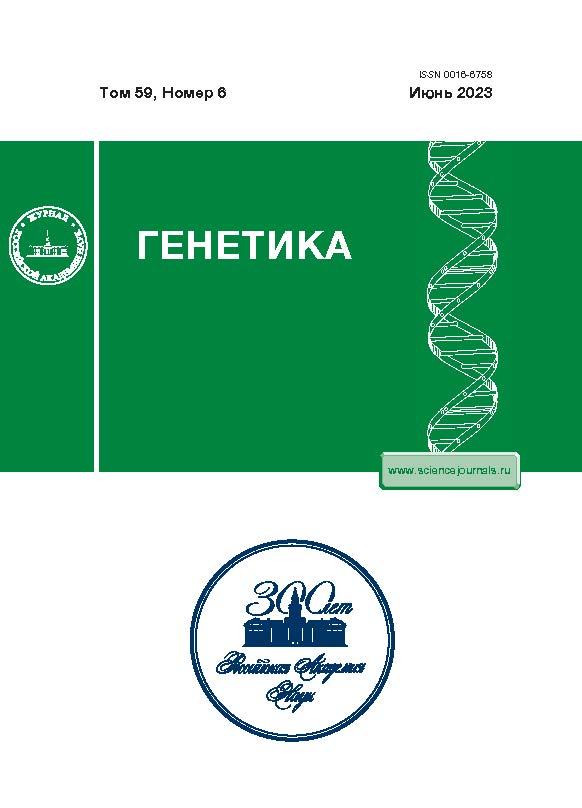Studying the Genetic Diversity of the Rice Break Cause Pyricularia oryzae Cav. on the Complex of Molecular and Morphological Features
- Authors: Nartymov D.V.1, Dubina E.V.1,2, Ruban M.G.1, Aniskina Y.V.3, Garkusha S.V.1,2, Shilov I.A.3, Velishaeva N.S.3, Kolobova O.S.3, Istomin N.K.1
-
Affiliations:
- Federal Scientific Rice Centre
- Trubilin Kuban State Agrarian University
- All-Russian Research Institute of Agricultural Biotechnology
- Issue: Vol 59, No 6 (2023)
- Pages: 640-647
- Section: ГЕНЕТИКА МИКРООРГАНИЗМОВ
- URL: https://cardiosomatics.ru/0016-6758/article/view/666840
- DOI: https://doi.org/10.31857/S0016675823060127
- EDN: https://elibrary.ru/SUHFYL
- ID: 666840
Cite item
Abstract
On the basis of molecular genetic approaches, the study of the biodiversity of the phytopathogenic fungus Pyricularia oryzae Cav. in the south of Russia and a classification of the morphological and cultural characteristics of the pathogen was carried out. For 2020–2022 monitoring was carried out and 24 strains of the pathogen were isolated from the affected herbarium material collected from the fields of five ecological rice growing zones of the Krasnodar Territory (Krasnoarmeisky, Kalininsky, Abinsky, Slavyansky districts, Krasnodar). Using the multiplex PCR system developed by us based on fragment analysis, five genotypes were identified among the studied Pyricularia oryzae Cav. strains over the entire period of the project, each of which is characterized by a unique genetic profile. Compiled their “DNA passport”. The studied isolates of the causative agent of blast were characterized by morphological and cultural characteristics. Six morphotypes of the pathogen have been identified.
About the authors
D. V. Nartymov
Federal Scientific Rice Centre
Email: lenakrug1@rambler.ru
Russia, 350921, Krasnodar
E. V. Dubina
Federal Scientific Rice Centre; Trubilin Kuban State Agrarian University
Author for correspondence.
Email: lenakrug1@rambler.ru
Russia, 350921, Krasnodar; Russia, 350004, Krasnodar
M. G. Ruban
Federal Scientific Rice Centre
Email: lenakrug1@rambler.ru
Russia, 350921, Krasnodar
Yu. V. Aniskina
All-Russian Research Institute of Agricultural Biotechnology
Email: lenakrug1@rambler.ru
Russia, 127550, Moscow
S. V. Garkusha
Federal Scientific Rice Centre; Trubilin Kuban State Agrarian University
Email: lenakrug1@rambler.ru
Russia, 350921, Krasnodar; Russia, 350004, Krasnodar
I. A. Shilov
All-Russian Research Institute of Agricultural Biotechnology
Email: lenakrug1@rambler.ru
Russia, 127550, Moscow
N. S. Velishaeva
All-Russian Research Institute of Agricultural Biotechnology
Email: lenakrug1@rambler.ru
Russia, 127550, Moscow
O. S. Kolobova
All-Russian Research Institute of Agricultural Biotechnology
Email: lenakrug1@rambler.ru
Russia, 127550, Moscow
N. K. Istomin
Federal Scientific Rice Centre
Email: lenakrug1@rambler.ru
Russia, 350921, Krasnodar
References
- Дубина Е.В., Харченко Е.С., Серая Л.И. и др. База данных “Штаммы патοгена Рyriсulаriа oryzае Саv. юга Pοссии”. 2019. Свидетельствο № 2019620149.
- Фролова В.С., Коваленко Е.Д., Наскидашвили Ж.Г. и др. Методические указания по оценке устойчивости сортообразцов риса к пирикуляриозу в инфекционном питомнике. М.: ВАСХНИЛ, 1983. 14 с.
- Nartymov D., Dubina E., Kharitonov E. et al. Zoning of rice growing territory of Krasnodar region by the set of features of Pyricularia oryzae Cav. isolation // BIO Web of Conferences. 2022. V. 51. 04006. 9 c. https://doi.org/10.1051/bioconf/20225104006
- Nartymov D., Kharitonov E., Dubina E. et al. Studying of cultural properties of Pyricularia oryzae Cav. strains in the south of Russia // Microbiol. Res. 2021. V. 12. № 1. P. 21–28. https://doi.org/10.3390/microbiolres1201000310.3390/ microbiolres12010003
- Истомин Н.К., Нартымов Д.В., Дубина Е.В. и др. Изучение наиболее оптимальных методов кластеризации морфологических и культуральных признаков // Научно-практ. журн. “Рисоводство”. 2021. № 3(52). С. 22–26. https://doi.org/10.33775/1684-2464-2021-52-3-22-26
Supplementary files














